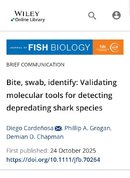After many years of volunteering on ocean research projects, I had my first scientific study published in the Journal of Fish Biology 

ABSTRACT
Depredation, the partial or complete removal of hooked fish by predators, poses significant challenges for fisheries worldwide. Shark depredation in recreational fisheries has become a growing concern, influencing both fisheries management and public perceptions of shark conservation.
Although DNA swabbing of depredated fish has been used to identify responsible shark species, the reliability of this technique remains uncertain due to potential environmental DNA (eDNA) contamination.
In this study, we evaluated the accuracy of swab-based molecular identification by comparing genetic results to video-confirmed depredation events.
Four depredation events were recorded in Jupiter, Florida, involving a bull shark (Carcharhinus leucas), lemon shark (Negaprion brevirostris), great hammerhead shark (Sphyrna mokarran) and great barracuda (Sphyraena barracuda).
DNA analysis of swab samples from depredated fish correctly identified the responsible shark species in all three shark cases. Barracuda depredation yielded no amplification.
Our findings validate the use of swab-based molecular techniques for accurately identifying depredating shark species and confirm the absence of misleading eDNA signals. This approach provides a valuable, non-invasive tool for studying predator–prey interactions and informing fisheries management strategies.
ABSTRACT
Depredation, the partial or complete removal of hooked fish by predators, poses significant challenges for fisheries worldwide. Shark depredation in recreational fisheries has become a growing concern, influencing both fisheries management and public perceptions of shark conservation.
Although DNA swabbing of depredated fish has been used to identify responsible shark species, the reliability of this technique remains uncertain due to potential environmental DNA (eDNA) contamination.
In this study, we evaluated the accuracy of swab-based molecular identification by comparing genetic results to video-confirmed depredation events.
Four depredation events were recorded in Jupiter, Florida, involving a bull shark (Carcharhinus leucas), lemon shark (Negaprion brevirostris), great hammerhead shark (Sphyrna mokarran) and great barracuda (Sphyraena barracuda).
DNA analysis of swab samples from depredated fish correctly identified the responsible shark species in all three shark cases. Barracuda depredation yielded no amplification.
Our findings validate the use of swab-based molecular techniques for accurately identifying depredating shark species and confirm the absence of misleading eDNA signals. This approach provides a valuable, non-invasive tool for studying predator–prey interactions and informing fisheries management strategies.




